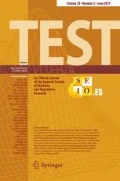This number of TEST exceptionally contains a selection of papers presented at the 2nd Workshop on Goodness-of-Fit and Change-Point problems held at the National and Kapodistrian University of Athens (NKUA), 4–6 September 2015, and hosted by the Department of Economics, NKUA. The first workshop in this series took place in 2012 at the University of Sevilla, while there is already a follow-up event, the third workshop on Goodness-of-fit and Change-Point Problems, that took place in 2017 at Bad Herrenalb (Germany), and was hosted by the Karlsruhe Institute of Technology. At this point, we would like to express our wish that this event becomes a regular international meeting.
The submitted papers form a subset of all invited papers presented during the workshop and were screened through a rigorous referring process according to the high standards of the journal. Our special thanks go to the authors and to the reviewers for their excellent job.
The paper by Ghoudi and Rémillard (2018) deals with testing the hypothesis of serial independence of the innovations of conditional mean and variance models, when both the mean and the variance are assumed to depend on all past observations as well as current information on exogenous variables; the paper by Francq et al. (2018) introduces an extension of the asymmetric Log-GARCH model, which generates a richer class of volatilities than the EGARCH models, and proposes two goodness-of-fit tests for such a model; the paper by Lee et al. (2018) considers the problem of testing for a parameter change in bivariate Poisson integer-valued GARCH(1,1) models, constructed via a trivariate reduction method of independent Poisson variables; the paper by Allison et al. (2018) develops testing procedures for regressor significance in a certain semi-parametric model which assumes that the response variable following a parametric transformation can be expressed by means of a regression model involving a given set of regressors; finally, the paper by Jiménez-Gamero et al. (2018) deals with estimation of the characteristic function of a finite population, with applications to the two-sample problem, testing for independence and testing for symmetry in such setting.
In closing, we wish to sincerely thank the Editors-in-Chief of TEST as well as the Associate Editor Prof. Wenceslao González-Manteiga for seeing this special issue through.
References
Allison JS, Hušková M, Meintanis SG (2018) Testing the adequacy of semiparametric transformation models. TEST. https://doi.org/10.1007/s11749-017-0544-4
Francq C, Wintenberger O, Zakoïan JM (2018) Goodness-of-fit tests for Log-GARCH and EGARCH models. TEST. https://doi.org/10.1007/s11749-016-0506-2
Ghoudi K, Rémillard B (2018) Serial independence tests for innovations of conditional mean and variance models. TEST. https://doi.org/10.1007/s11749-016-0521-3
Jiménez-Gamero MD, Moreno-Rebollo JL, Mayor-Gallego JA (2018) On the estimation of the characteristic function infinite populations with applications. TEST. https://doi.org/10.1007/s11749-016-0514-2
Lee Y, Lee S, Tjøstheim D (2018) Asymptotic normality and parameter change test for bivariate Poisson INGARCH models. TEST. https://doi.org/10.1007/s11749-016-0510-6
Author information
Authors and Affiliations
Corresponding author
Additional information
S. G. Meintanis is on sabbatical leave from the University of Athens.
Rights and permissions
About this article
Cite this article
Meintanis, S.G., Hušková, M. & Jiménez-Gamero, M.D. Editorial. TEST 27, 1–2 (2018). https://doi.org/10.1007/s11749-018-0577-3
Published:
Issue Date:
DOI: https://doi.org/10.1007/s11749-018-0577-3

